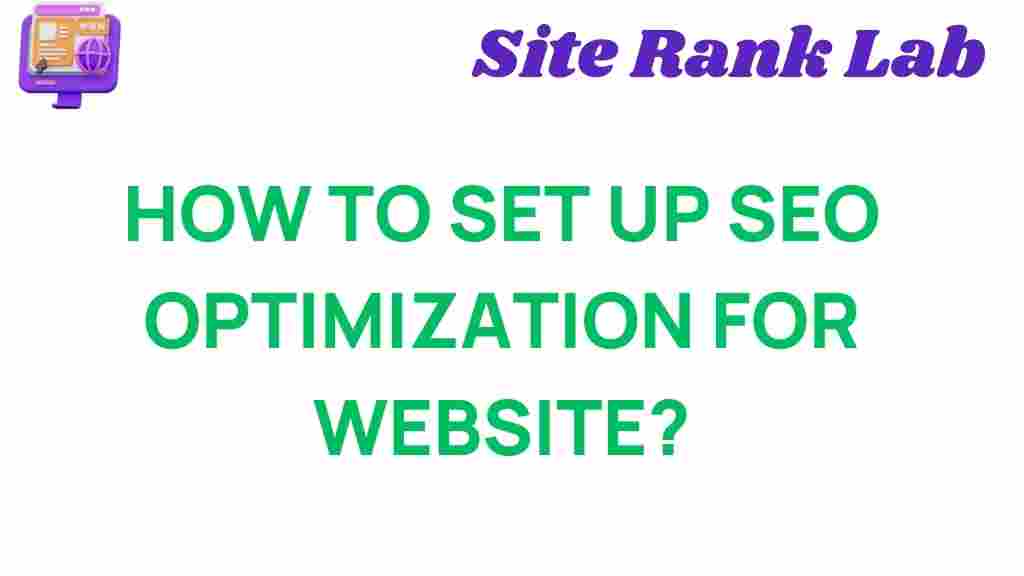How to Set Up SEO Optimization for Your Website
In today’s digital age, having a website isn’t enough. You need to ensure your website is optimized for *search engines* to stand out among competitors and attract the right audience. Search Engine Optimization (SEO) plays a critical role in increasing visibility, driving organic traffic, and improving user experience. In this guide, you’ll learn everything you need to know to set up SEO optimization effectively for your website.
Why is SEO Important?
SEO helps your website rank higher on search engines like Google, making it easier for potential customers to find you. A well-optimized site ensures a better user experience, drives more traffic, and boosts conversions. Without proper SEO, your website may remain invisible in search engine results, regardless of its quality.
Step-by-Step Guide to Setting Up SEO Optimization
1. Conduct Keyword Research
Keyword research is the foundation of successful SEO. It helps you identify the terms and phrases your target audience is searching for. Use tools like Ahrefs or Google Keyword Planner to find high-volume, low-competition keywords. Focus on a mix of primary and long-tail keywords for better targeting.
2. Optimize Your Website Content
Content is king in the world of SEO. Ensure your website offers high-quality, relevant, and engaging content. Incorporate your target keywords naturally into:
- Page titles
- Meta descriptions
- Headings (H1, H2, H3)
- Body text
Avoid keyword stuffing, as it can harm your rankings. Aim for a keyword density of 1-1.5% to maintain readability while optimizing for search engines.
3. Optimize On-Page Elements
On-page SEO focuses on improving individual web pages. Ensure your website includes the following:
- Title Tags: Use compelling, keyword-rich titles.
- Meta Descriptions: Write concise summaries that include primary keywords.
- Header Tags: Structure content with H1, H2, and H3 tags for readability.
- Image Alt Text: Add descriptive alt text for images, incorporating relevant keywords.
4. Enhance Site Speed and Mobile Responsiveness
Search engines prioritize fast-loading, mobile-friendly websites. Use tools like Google PageSpeed Insights to evaluate your site’s speed and make improvements. Compress images, leverage browser caching, and ensure your site is responsive across devices.
5. Build Quality Backlinks
Backlinks from authoritative websites signal trust to search engines. Focus on earning backlinks through:
- Guest blogging
- Creating shareable content
- Engaging with influencers
Avoid spammy links, as they can lead to penalties.
6. Monitor and Analyze Performance
Regularly track your SEO efforts to measure progress and identify areas for improvement. Use tools like Google Analytics and Search Console to monitor:
- Organic traffic
- Keyword rankings
- Click-through rates
- Site performance
Common SEO Troubleshooting Tips
SEO is a long-term game, and challenges are inevitable. Here are solutions to common issues:
- Low Rankings: Reevaluate your keyword strategy and focus on high-quality backlinks.
- Slow Site Speed: Optimize images, minimize code, and use a reliable hosting service.
- High Bounce Rates: Improve your content’s relevance and ensure fast loading times.
- Mobile Usability Errors: Test your site’s mobile responsiveness and fix any design issues.
Conclusion
Setting up SEO optimization for your website is essential for unlocking its full potential. By following this step-by-step guide, you can create a strong foundation for long-term success. Remember to regularly update your content, monitor your performance, and stay informed about the latest SEO trends.
For more tips on improving your website’s performance, visit our comprehensive resource page.
This article is in the category SEO and created by SiteRankLab Team
